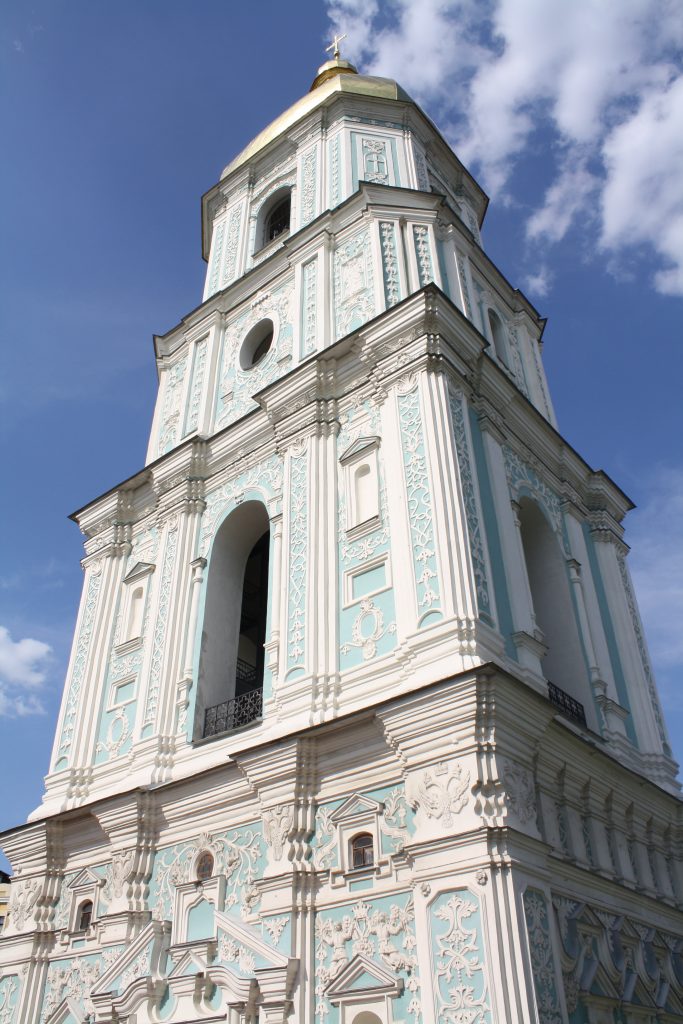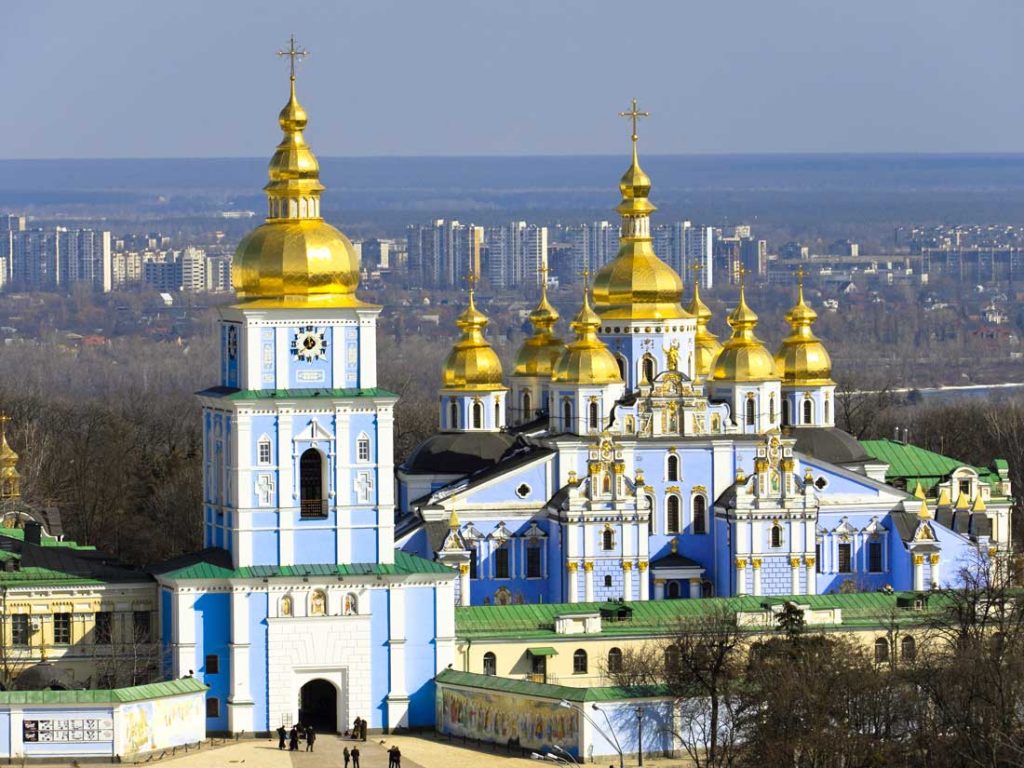Download the Kyiv Guide Brochure
 Kyiv is the cradle of Slavic civilization and one of the most ancient, majestic, and beautiful cities of Europe. For good reasons, Honore de Balzac called it the Eternal City, Northern Rome. Not every European capital can be proud of such a long history and so many cultural landmarks. Kyiv’s original appearance and ancient traditions are combined seamlessly with modernity, and its distinct charm and hospitality make it one of the most appealing cities of not only Ukraine, but of the whole world.
Kyiv is the cradle of Slavic civilization and one of the most ancient, majestic, and beautiful cities of Europe. For good reasons, Honore de Balzac called it the Eternal City, Northern Rome. Not every European capital can be proud of such a long history and so many cultural landmarks. Kyiv’s original appearance and ancient traditions are combined seamlessly with modernity, and its distinct charm and hospitality make it one of the most appealing cities of not only Ukraine, but of the whole world.
Kyiv, whose history goes back over 1500 years, was named after Kyi, the elder of the two legendary brothers who created the city with their sister, Lybid. A competing legend claims that the city got its name from its first citizens, the kiyans, who maintained the Dnieper River crossing.
In the 9th century, Kyiv became the capital of one of the most powerful states of Eastern Ukraine: Kyivan Rus. At that time it was an important political, economic, and cultural center. After the year 988, when Prince Vladimir converted Rus to Christianity, Kyiv became a spiritual capital and is until today one of the most famous Christian cities in the world. The city lost its power when the Mongol-Tatars overran it in 1240. After that, Kyiv was a part of the Grand Duchy of Lithuania, Russia, the Ukrainian Soviet Republic, and, since 1991, the capital of independent Ukraine.
It is best to start discovering the Ukrainian capital from its center, the Independence Square. It is the heart of Ukraine, which beats in unison with current events. It obtained its modern look only recently – in 2001, new monuments, sculptures and fountains were built here. At the same time, a tall column with a statue of a girl holding a cranberry branch, the symbol of Ukraine’s independence, was raised in its center. Today, this monument is one of the capital’s most famous landmarks.
To its visitors, Kyiv is a real marvel! This city history witnessed and participated in many important events and years of hardship and prosperity. Now, it shares its wisdom and charm with each of its guests. Kyiv’s majestic churches, fantastic landscapes, peculiar architecture, unusual museums, and unique monuments will make you fall in love, and you will dream of visiting it again and again.
Kyiv-Pechersk Lavra (Monasstery of the Caves)

The Kyiv Pechersk Lavra, also known as the Kyiv Monastery of the Caves, is an ancient cave monastery in Kyiv. It was founded in 1051 by monks Anthony and Theodosius, and has become an important center of Orthodox Christianity in Kyivan Rus’. Its ongoing development and construction followed for the next 9 centuries. The word “pechera” means cave in the Slavic tongue. The word “lavra” is used to describe high ranking monasteries of the Eastern Orthodox Church. The Lavra buildings looked like small towns with their own streets. In Greek “lavra” means “the street”.
According to the Russian Primary Chronicle, in the early 11th century, Antony, a Greek Orthodox monk from Esphigmenon monastery on Mount Athos, originally from Liubech of the Grand Principality of Chernigov, returned to Rus’ and settled in Kyiv as a missionary of monastic tradition to Kyivan Rus’. He chose a cave at the Berestov Mount that overlooked the Dnipro River and a community of disciples soon grew. Knyaz (prince) Iziaslav of Kyiv ceded the whole mount to the Antonite monks who founded a monastery built by architects from Constantinople. For more than 900 years the imperishable bodies of the monastery’s founders – the Venerable Anthony and Theodosius, Agapit the healer, Nestor the Chronicler, and relics of another 118 saints lie here. There are 102 stone structures set in a 26 hectares area, which are recognized architectural monuments. There are also many wonderful paintings, works of arts, old-painted books and crafts.
St. Sofia’s Cathedral
 The St. Sofia’s cathedral is the most ancient temple of Kyiv Rus. The first state to arise among the Eastern Slavs. It took its name from the city of Kyiv, the seat of the Grand Prince from about 880 until the beginning of the 13th century. At its zenith, it covered a territory stretching from the Carpathian Mountains to the Volga River, and from the Black Sea to the Baltic Sea. )
The St. Sofia’s cathedral is the most ancient temple of Kyiv Rus. The first state to arise among the Eastern Slavs. It took its name from the city of Kyiv, the seat of the Grand Prince from about 880 until the beginning of the 13th century. At its zenith, it covered a territory stretching from the Carpathian Mountains to the Volga River, and from the Black Sea to the Baltic Sea. )
The St. Sofia’s cathedral was constructed in 1037. Some hundreds of square meters of the original 11th century mosaics and frescos can be seen in the cathedral, including the scenes of everyday life in Old Kyiv. These are unique frescos that can be found nowhere else neither on the territory of former Kyivan Rus nor in Europe. The famous Grand Prince of Kyiv Yaroslav the Wise was buried in the cathedral in 1054. St. Sofia’s Cathedral is included in the World Heritage List of UNESCO.
The cathedral’s name comes from the 6th-century Sophia cathedral in Constantinople (meaning Holy Wisdom, and dedicated to the Holy Wisdom rather than a specific saint named Sophia) (Present day Istanbul). Architecture-wise, its model could have been the 13-domed oaken Holy Sophia Cathedral in Novgorod (c. 989), which Yaroslav I the Wise determined to imitate in stone as a sign of gratitude to the citizens of Novgorod who had helped him secure the Kyivan throne in 1019.
The first foundations were laid in 1037 or 1011, but the cathedral took two decades to complete. According to Dr. Nadia Nikitenko, the cathedral was founded in 1011, under the reign of Yaroslav’s father, Grand Prince of Kyivan Rus’, Volodymyr the Great. This info has been accepted by both UNESCO and Ukraine, which officially celebrated the 1000th anniversary of the cathedral during 2011. The structure has 5 naves, 5 apses, and (quite surprisingly for Byzantine architecture) 13 cupolas. It is surrounded by two-tier galleries from three sides. Measuring 37 to 55 m (121 to 180 ft), the exterior used to be faced with plinths. On the inside, it retains mosaics and frescos from the 11th century, including a dilapidated representation of Yaroslav’s family, and the Orans.
On 21 August 2007, the Holy Sophia Cathedral was named one of the Seven Wonders of Ukraine, based on votes by experts and the internet community.
 |
 |
 |
 |
| The Virgin Orans, c. 1000 |
Saint Sophia The Wisdom of God, 1700 | Church Fathers Order, c. 1000 |
The Annunciation. The Archangel Gabriel, 1000 |
St. Michael’s Golden-Domed Cathedral

This multi-tiered church complex is situated just opposite Sophia Cathedral and seems to reign on the steep bank of the Dnipro in all its glory. Originally built by a grandson of Yaroslav the Wise, Kyiv Prince Sviatopolk Izyaslavovych in 1108, this cathedral was one of the biggest monasteries of ancient Kyiv. St. Michael’s Cathedral, hallowed in the name of Kyiv’s saint patron – Archangel Michael. Since the beginning of the thirteenth century the Monastery had kept its prized sacred object – St. Martyr Barbara’s relics. Now the relics reside at St. Vladimir’s Cathedral.
“The substantial stone construction started in 1710, when the stone refectory, three-tiered belfry and the Cathedrals two large side-chapels were erected. The latter’s construction was filled unsuccessfully, and, as a result the Cathedral started to decline in ruin. In 1740 a reinforcment of the abutments to strengthen the walls was done.
The Cathedral’s original interior was adorned with Old-Rus’ mosaics and frescos. Some of them were discovered during the reconstruction of 1888. The Cathedral’s famous altar mosaic composition “Evcharistia” was preserved, and is on exhibit now in St. Sofia Cathedral. Some of the single fresco and mosaic images are now kept in museums of Moscow and St. Petersburg.” St. Michael’s Golden Domed Cathedral and some of the Monastery buildings were destroyed in 1934 through 1936 by the Soviet regime of the mid-30s in keeping with their anti-religious propaganda for building a Soviet government center instead. (Currently the Ministry of Foreign affairs building). Its reconstruction of the original site was completed in 2000 and is a sign of spiritual rebirth of Kyiv. The sky blue exterior and glittering golden domes seem a bit too new and shiny for this ancient city, but they are certainly stunning.
Independence Square

The Independence Square, or Maidan Nezalezhnosti, is the central square in Kyiv, the main and the most beautiful one. Parades, concerts, festivals and other city arrangements and holidays take place on this square. It contains six fountains, Independence Column and artificial waterfall. The left side of the Independence square is covered with granite. The splendid panoramic view of Old Kyiv opens from the upper floors of the square buildings. You can see the domes of St. Sofia`s Cathedral built in the 11th century, Andriyivska Church built in the 18th century, City Parliament, the Central Mall, and a lot of administrative buildings. There are lots of shops, hotels and cafes here.. Close by, you will find Kreschatyk and Maidan Nezalezhnosti metro stations.
One of the fountains of the square is decorated with statues of legendary brothers Kyi, Schek, Khoryv and their sister Lybid. According to the Chronicles they chose the place for the city foundation and decided to name it in honor of the elder brother as Kyi. The sculpture composition on Kyiv central square depicts the four founders of the city.
Till the end of the 10th century the site of Independence square used to be occupied by forests. In the 18th century on the that patch of land the Pechersk Gate was put up, but the square still looked like an abandoned lot called Goat Swamp. In 1833 the gate was destroyed, but in the modern pedestrian subway system the basements of the Pecherski Gate are preserved.
One of the best notable decorations of the central square is the Independence Column topped with a statue of Archangel Mikhail, who is considered to be the saint patron of Kyiv. In front of the column, at the end of the square there is an arch decorated with the statue of Archangel with a sword and a shield. Another attraction of the square is 5,000-sprays fountain called Friendship of Nations designed by architect Komarovsky.
Khreshchatyk Street

Khreshchatyk is the most famous and one of the busiest streets in Kyiv. It is a wide boulevard with plenty of chestnut trees. It is hard to believe that some time ago on the site of Khreshchatyk there used to be a valley and a river surrounded by forest. The valley was called Kreshataya (Crossed) because it was intersected by many ravines. It was one of the most favorite hunting places of Kyiv princes. Along the bank of the river through the valley an important trade route passed. In the end of the 18th century the first construction appeared on the right side of the road. Gradually the left side of the road was also built up with dwelling houses, and in 1805 the first Kyiv Theater appeared in the street. Nowadays on the site of the theater the Ukrainian House is situated.
Khreshchatyk got its final modern shape in 1837. It stretches from European Square till Bessarabia Square and contains many important trade buildings, bank departments, luxurious restaurants, hotels and exchange house.
The architectural look of the Khreshchatyk Street was changing gradually. For a long time beautiful stone buildings adjoined haulm-roofed houses and clay-walled huts. In the puddles one could see pigs, and it was impossible to cross Khreshchatyk without special devices, such as stilts. There were people called bosyaki, or tramps, who took money for carrying people from one side of Khreshchatyk to another. The situation changed after canalization system installation. The street was paved with granite cubes and became elegant and fashionable.
By the end of the 19th century Khreshchatyk became the main Kyiv thoroughfare. It was the place where the venues famous all over the country, such as Semadeni confectionary and Tarasova’s dairy were located. The popular stores and restaurants turned into sources of the freshest news, as their owners received English, Belgium, German, French, Petersburg and Moscow newspapers and magazines two or three days earlier than the rest of the city. Nice buildings and refined street lamps, monuments to Alexander the Liberator and Stolypin made Khreshchatyk a very charming street. The first tram in the country went along Khreshchatyk Street.
The fate of Khreshchatyk during the World War I and the World War II was tragic: the street was badly damaged and destroyed. In 1943, immediately after Kyiv liberation, reconstruction works on Khreshchatyk started. After the work was finished, the street became “higher and wider” than it used to be. Today its buildings perfectly harmonize with the surrounding landscapes.
Nowadays Khreshchatyk ranges among the major attractions of Kyiv. The citizens of the city adore this street, and the guests of Kyiv try to visit it and feel its charming atmosphere first of all. Such Khreshchatyk buildings as Kyiv City Council, Central Department Store, the National Philharmonic, as well as other administrative constructions, stores, hotels and metro stations deserve special attention of Kyiv guests.
Andriyivskyi Spusk

Andriyivskyi Spusk is one of the oldest streets in Kyiv. In ancient days it was the shortest way from the Upper Town to the Podil, or the Lower Town, where merchants and craftspeople used to live. Nowadays this steep and meandering street is a traditional place for arranging concerts, art festivals and city holidays. On Andriyivskyi Spusk there are many interesting picture galleries and souvenir stores. This street is often called Kyiv’s Montmartre, as any time one can see here artists displaying their works. It is also the place where singers and actors give their performances.
One of the major attractions of Andriyivskyi Spusk is Andriyivska, or Saint Andrew’s, Church. There is a legend that says that on the site where the Dnepr River flows nowadays, a sea used to be. When Saint Andrew came to Kyiv and placed a cross on the site where Andriyivska Church now stands, the sea receded, and only some water remained under the Andriyivska Mountain. When the church was built, a spring appeared under the altar. That’s why Andriyivska Church doesn’t have bells. The legend goes that the sound of bells would awake sleeping water, and Kyiv would be overflowed.
Andriyivska Church is the perfect example of baroque style: it features efficiency, magnificence, plenty of gold and rich decoration. Expressiveness and eccentricity make Andriyivska Church one of the masterpieces of native architecture of the 18 century. Among its sacred objects is a part of Saint Andrew relics that was delivered from Italy and now is kept in precious shrine. Pilgrims also value the Gospel in diamond setting that was presented to the church by Emperor Alexander.
Download the Kyiv Guide Brochure
More information about Kyiv:
http://en.wikipedia.org/wiki/Kiev



